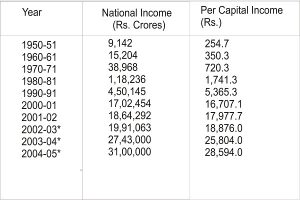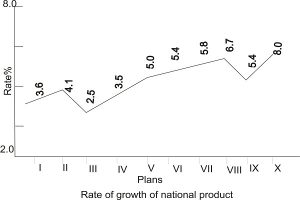Table of Contents
BA LLB Economics notes 1st semester
In the below post you will read
National Income estimation in India
a complete explanation for you.
you can follow @freegooglenotes
or you may also read:-

Q. 3. Discuss the trends in National Income estimation in India.
Ans. In India, the first attempt to estimate national income and per capita income was made in the year 1867-68 by Dadabhai Naoroji.(Economics notes )
This was followed by several intermittent efforts by individuals, officials as well as non-official. All these èstimates are at current prices and differ widely in territorial coverage, conceptual basis, method of estimation, and basic data used. They do not provide a series of comparable estimates adequately reliable to study the growth of the Indian economy over the period.
Immediately after Independence, the Government set up the National Income Committee in August 1949 to prepare a report on national income and related estimates, to suggest improvements in the collection of data, and to recommended guidelines for research in the field of national income. The committee comprised three noted economists, Prof. P. C. Mahalanobis, Prof. D. R. Gadgil, and Dr. V. K. R. V. Rao. Sir Simon Kuznets was a special invitee member of the committee.
The First Report of the Indian National Income Committee was published in 1951, and their Final Report in 1954. The Committee made certain recommendations, and as a result of that, the coverage of area statistics was enlarged through surveys and the establishment of reporting agencies in areas where no agency existed before. The Directorate of National Sample Survey came into existence in 1950 to collect additional data required for national income estimation. The task of national income estimates was later on assigned to the Central Statistical Organisation. The CSO has been producing annual official estimates of the national income of India since 1955 and publishing it annually in National Accounts Statistics (NAS). Further, the National Sample Survey Organization and the Research Cells in the Reserve Bank of India and State Income Units in the State Statistical Organisations have been publishing data that constitute a useful supplement to the NAS and aid in the analysis of growth and change in the economy. It is with the help of this data that we shall try to establish the trend in India’s national income over the last five decades.(Economics notes )
India’s National Income and per Capita Incomé at Current Prices

*Projections
Overall Trends: The rate of growth of the national product during each of the plans is summarised in fig.

From an overall study of the total period, the following trends can be observed :
(1) The real national income of India has increased at an annual average rate of 4.0 percent. During this period, the population has also increased at an annual average rate of 2.00 percent. Therefore, the per capita income has increased only at a nominal annual average rate of 2.0 percent.
(2) The rate of growth initially decelerated over the years but has Subsequently accelerated continuously. During the first decade, real national income went up by 3.8 percent, this rate came down to 3.5 percent in the 1960s, and 3.1 percent in the 1970s. A reversal of trend Occurred during the 1980s: the rate of growth was around 5.5 percent per annum during the decade. The rate of growth further accelerated during the decade of the 1990s to go up to about 6.0 percent per annum. Presently, the economy is all set to grow at a still higher rate of 7.0 percent which may go on to become about 8.0 percent during the Tenth Plan.
(3) Similarly, the per capita income went up by 1.8 percent during the 1950s, 1.2 percent during the 1960s, and 1.1 percent during the 1970s. Reversing the trend it went up by about 3.6 percent per annum during the 1980s and 4.1 percent per annum; during the 1990s. Presently, per capita income is rising at about 5.2 percent per annum and is expected to accelerate further to 6.3 percent during the Tenth Plan.
(4) Fluctuations in year-to-year growth rates in early stages were very marked, which indicated that the economy had failed to create conditions
conducive to stable economic growth. We depended on chance factors, like a monsoon. Such impressive growth rates as were witnessed in the past were due to chance elements rather than due to planned efforts.
Recent growth has been more robust; it has been less vulnerable to agricultural performançe and to vagariês of the monsoon.
(5) In the initial stage there was a tendency towards an increase in the element of fluctuations over succeeding decades. But it seems to have been subdued now.(Economics notes pdf)
(6) An examination of the annual rates. of change-observed by the three sectors of the economy, primary, secondary and tertiary- further shows that the annual variations are not specific. to anyone sector. Fluctuations are observable in all the sectors, although their order of magnitude.is highest in the primary, sector, followed by the secondary sector and the tertiary sector in that order.









